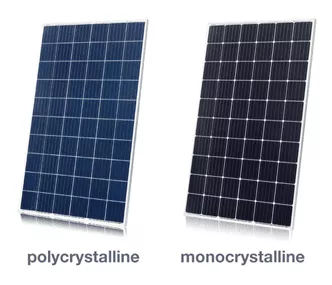当您评估光伏系统的太阳能电池板时, 您将遇到两个广泛的面板: 单晶与多晶太阳能光伏面板. 本文详细介绍了这两种类型的太阳能电池板之间的关键差异,以便您确定最佳的太阳能电池板.
太阳能电池板的类型
目前市场上的太阳能电池板主要分为三种: 单晶, 多晶和薄膜.
单晶太阳能电池板

单晶硅 太阳能板, 也称为单晶面板, 今天是屋顶太阳能电池板安装中最受欢迎的太阳能电池板. 它们是由单个纯硅晶体制成的. 纯硅的使用使它们以高效率和小尺寸而闻名, 使它们成为所有三种太阳能电池板类型中最高效率和耐用的.
多晶太阳能电池板

多硅氧核桃 硅 太阳能电池板由多核硅制成, 它来自不同的硅晶体,通常具有蓝色外观,并且在晶粒之间具有不规则边界. 多硅太阳能电池板便宜, 它们的硅纯度和结构低于单晶面板, 但这也使他们在能源转化方面效率降低, 空间, 和耐热性.
薄膜太阳能电池板

除了单晶与多晶, 有薄膜太阳能电池板. 薄膜面板的特征是具有非常细和薄的层, 而且它们通常在灵活性和轻巧方面具有优势. 每个面板不需要框架备份, 使它们更轻便,更易于安装. 与结晶硅面板不同, 标准化的大小 60, 72 和 96 细胞, 薄膜面板可以以不同的尺寸制作以满足特定需求. 然而, 它们的效率不如典型的硅太阳能电池板.
什么是单晶与多晶太阳能光伏面板

单晶与多晶太阳能电池板是两种最常见的太阳能电池板类型. 两者都使用由硅制成的光伏电池, 与使用的材料相同 电子芯片. 像所有太阳能电池板一样, 他们捕获太阳能并将其转换为电力.
有两种单晶硅板:
- 钝化发射机和后接触 (PERC) 面板: PERC面板最常用于屋顶安装. 它们的光伏电池在背面有一个额外的导电层,以增加吸收能量.
- 双面面板: 双面面板可以吸收这两个面的光,并且比PERC面板具有更高的吸收率. 它们通常保留用于接地系统, 离开面板的两侧暴露. 双面面板也用于遮阳篷, 檐篷和高度反光的白色商业屋顶.
多晶硅面板是使用较早的太阳能技术制造的, 因此,它们比较新的单晶硅面板便宜. 然而, 由于较旧的技术, 多晶面板的效率不如其现代同行.
单晶和多晶太阳能光伏面板之间的差异
Mono vs聚太阳能电池板效率
太阳能电池板效率表明您的面板如何将太阳能转换为电能, 以百分比表示, 效率越高, 产生的电力越多. 例如, 效率 20% 意思是 20% 太阳辐射转换为电力, 而失踪 80% 被转化为热量.
一般来说, 单晶太阳能电池板比多晶太阳能电池板更有效,因为它们是从单晶硅切割的, 使最大电量更容易在整个面板上移动. 单晶硅面板的效率在 15% 和 25%, 多晶太阳能电池板的效率较低, 在 14% 到 17%.
单晶太阳能电池板的另一个优点是,它们的细胞的晶体纯度意味着它们的生产开始较早,并且比多晶太阳能电池板停止了. 这种类型的面板不仅更有效, 但发电期比多晶太阳能电池板更长.
Mono vs Poly太阳能电池板价格
分别比较面板时, 单晶太阳能电池板比多晶太阳能电池板更昂贵. 多晶太阳能电池板通常成本 $0.40 和 $0.50 每瓦, 而单晶太阳能电池板之间的成本 $0.50 和 $0.80 每瓦.
但这并不意味着一个水晶太阳能电池板可能不是您最好的选择, 硅结构是确定这两种太阳能电池板类型之间成本差的主要因素. 生产多晶面板, 制造商必须简单地将熔融硅倒入方形模具中,然后将所得的晶片切成单个细胞. 反过来, 为了产生单晶面板, 必须非常仔细控制硅的凝固, 单晶面板的过程更为复杂, 这使单晶太阳能电池更昂贵.
寿命
构成太阳能电池板的硅电池的类型通常不会影响面板的寿命. 正确维护时, 两种单晶与多晶面板都可以有效地产生电力 25 年或更久.
两种类型的太阳能电池板都有两个保修, 身体保修和效率保修. 物理保证通常是 15 到 30 年覆盖任何身体损害.
美学

太阳能电池的外观也是其硅结构的结果, 单晶和多晶太阳能电池板之间的主要美学差异是它们的颜色: 单晶面板通常是黑色的, 虽然多晶面板可能会显示为蓝色. 人们通常更喜欢单晶太阳能电池板的外观, 黑色面板可以更好地与更多的屋顶混合.
温度系数
温度系数表示太阳能电池板受温度影响的程度. 所有太阳能电池板均在同一标准测试条件下进行工厂测试 (标准技术委员会) 确保公平比较. 温度系数越高, 面板的功率输出在该范围以外的温度下下降.
一般来说, 多晶太阳能电池板倾向于具有较高的温度系数, 这意味着它们在高温下的生产力较低. 单晶硅板的温度系数低,耐热性很好.
哪个是更好的单太阳能电池板
每种类型的太阳能电池板都有优点和缺点, 两者都可以赚取良好的投资回报. 您的决定取决于您的个人喜好, 空间限制和融资选择.
您想要特定的太阳能电池板吗?
如果您认为太阳能电池板的颜色很重要, 请记住,单晶的颜色与polycrystalline硅面板不一样. 单晶面板是黑色的, 而多晶面板是蓝色的. 您可以购买适合您口味的太阳能电池板.
您为太阳能电池板有多少空间?
如果您的光伏系统的大小受到屋顶可用的空间的限制, 更有效的单晶硅面板是一个不错的选择. 对于需要更少空间和能量的应用程序也是如此, 例如为RV和小型设备提供动力. 为更有效的单晶硅面板支付额外费用,可以帮助您长期发电. 如果您有很多屋顶空间或正在安装地面安装太阳能, 效率较低的多晶面板可能是更经济的选择.
您的预算和融资选择是什么?
您的系统的融资方式也将影响您选择的哪种类型的面板. 多晶太阳能电池板便宜, 但是单晶太阳能电池板更有生产力. 如果您可以访问具有良好利率的太阳能贷款选项, 您可以为太阳能安装提供资金,并使用公用事业节省偿还贷款. 在这种情况下, 为高效的单晶太阳能电池板支付更多费用,可以为您的太阳能投资带来更高的回报.
结论
简而言之, 无论您选择单晶还是多晶硅面板, 这一切都取决于您的屋顶空间, 预算和个人喜好. 一个面板更有效, 需要更少的空间, 但是成本更高. 多硅太阳能电池板效率较低,需要更多的屋顶空间, 但是他们便宜.
大多数太阳能公司都提供单晶与多晶太阳能光伏面板. 立即从GYCX太阳能开始您的太阳能旅程. 您可以尝试填写下面的表格以获取报价,我们将与当地的太阳能公司联系,这些太阳能公司将根据您的需求量身定制的太阳能报价竞争您的业务. 多于 10 百万人每年访问Energysage以了解, 购买和投资太阳能.
常问问题
太阳能电池技术仍在改善?
现在, 许多科学家正在研究如何提高太阳能电池的效率. 例如, 能源部的国家可再生能源实验室 (nrel) 是高效太阳能电池研究的领导者.
可以混合单晶与多晶硅太阳能电池?
从技术上讲, 是的. 您可以混合单晶与多晶太阳能电池, 但不建议这样做,因为其他细胞为每个面板提供不同的电气特性. 如果您有兴趣由于特定情况而混合它们, 最好联系电工或专业安装程序. 电压等因素, 瓦数, 并且需要仔细考虑每种面板类型的当前.
单晶细胞和面板的优点是什么?
单晶细胞和面板通常具有最高的效率, 通常在 15 到 20 百分比甚至更高. 此外, 他们每平方英尺的功率输出比多元利的选项更高, 节省空间. 它们在温暖的天气中也倾向于更有效, 如果您生活在温和到温暖的气候中,这是理想的选择. 最后, 由于单晶硅面板的耐热性更好, 预计他们的使用寿命将更长,通常有25年的保修. 有关各种面板类型的预期寿命的更多信息, 请阅读我们有关太阳能电池板的使用寿命的文章.
哪种类型的太阳能电池板在炎热气候中效果更好?
单晶硅面板的温度系数低, 这意味着他们可以承受高温. 单面板在热中效果很好, 干燥的环境. 然而, 他们受温度较低的影响.
单晶和多晶太阳能光伏面板有什么区别?
单晶和多晶太阳能电池板之间的差异在许多地方反映, 例如Mono vs Poly太阳能电池板价格, 效率, 外貌, ETC. 多晶太阳能电池板使用由多个硅晶体制成的蓝色电池,效率较低,但便宜. 单晶面板的黑细胞由单晶制成, 他们以更高的价格提供较高的效率.
